 Palo Alto Stanford Heritage
Palo Alto Stanford Heritage 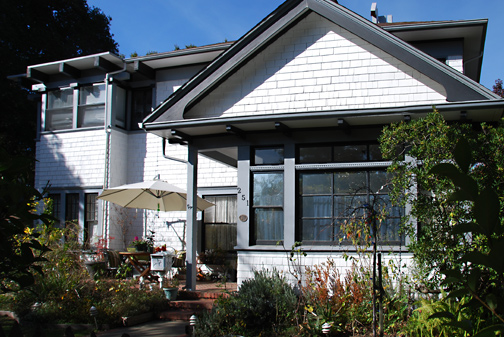 |
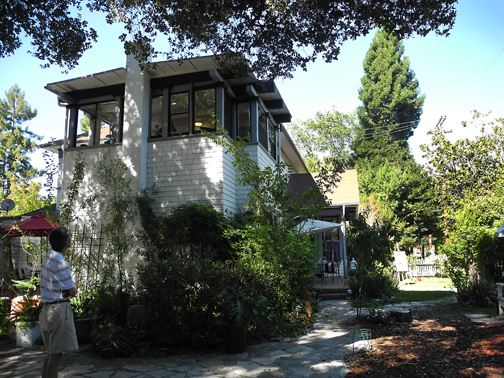 |
| January 2012 photo | August 2013 photo |
Samuel W. Charles and Isabel Peck Charles were married in 1900, shortly after Isabel’s graduation from Stanford. Samuel, whose father was a Palo Alto physician and health officer, had been the principal of Palo Alto schools from 1895 to 1896. After graduating from Stanford Law in 1898, he served as Justice of the Peace and taught at the law school. A railroad crossing accident took his life in 1916, leaving Isabel to raise two children.
In 1917, Isabel became the first woman in California to be appointed as Justice of the Peace (for Stanford, Los Altos and the unincorporated areas of Palo Alto). Within 18 months, she received her law degree from Stanford and, in 1918 was officially elected as Justice of the Peace, a post she held for 11 years. Although California women achieved suffrage in 1911, there was still skepticism concerning a woman’s ability to preside over civil and criminal cases. Charles’ performance erased all doubt that women might not have the “judicial mind” to perform as well as men. Commented Justice of the Peace Charles Creighton: “Of course women have judicial minds the same as men have—that is, some men—for I have known men who had as little ability to judge fairly as women are so wrongfully reputed to have.” The variety of cases heard by Judge Charles included domestic relations, small claims, assault and battery, drunkenness and speeding. Faced with the constantly recurring problem of spousal abuse, she determined that economic independence for women was the only way to end the cycle of domestic violence.
Shortly after their marriage, Samuel and Isabel commissioned a house to be designed by Stanford’s resident architect, Charles Edward Hodges (1866-1943). Charles Edward Hodges (1866-1943) worked for the London architectural firm of N. S. Joseph & Pearson from 1884 to 1888 while a student at Westminster and South Kensington Architectural Schools. At the age of 24, he immigrated to Boston where he was employed from 1888 to 1899 as a draftsman by the Boston firm of Shepley, Rutan and Coolidge. Coolidge’s firm, founded by the noted architect H. H. Richardson, was hired by Jane and Leland Stanford in 1888 to design the university which would commemorate their son, Leland, Jr., who had died in 1884. Coolidge sent Hodges west in 1893 to serve as draftsman and supervising architect for the Stanford project. Recently married to Myrtis Delano Charles and soon to be the father of three children, he settled on campus in Pine Cottage. Hodges’ main body of work consists of two distinct periods: The Stanford Years: 1893–1906, when he designed the earliest faculty housing and professor’s residences in Palo Alto and also supervised the construction of Stanford’s institutional buildings, and the San Francisco Bay Area Years: 1910–1917. His domestic architecture allowed him free rein to demonstrate his architectural skill without interference from his employers. By 1899, the Stanfords severed ties with the Coolidge firm and Jane Stanford appointed Charles Hodges resident architect in 1900, a post he held until 1906.
Hodges had emigrated from England at the age of 24 to work as a draftsman at the Boston architectural firm of Shepley, Rutan and Coolidge. In 1893, Coolidge sent Hodges to California to serve as draftsman and supervising architect on the firm’s commission to design Stanford University (see The Bertha Berner House). From 1893 to 1906, while overseeing the design and construction of major campus buildings, he also designed the earliest faculty houses both on campus and in Palo Alto. Hodges’ designs in a variety of architectural styles ranging from Queen Anne, Shingle, Eastlake, Craftsman, Colonial, Neo–Classical Revival and Tudor Revival reflect the preferences and pocketbooks of his clients. Many of his Palo Alto houses are in the National Historic District of Professorville including the modest Colonial Revival he designed for the Charles family.
This 2-story, 3,020 square foot house was enlarged early in the 20th century by adding a two–story addition at the left and a one–story entry porch at the right. Before its remodel, it was a twin of the house at 1102 Ramona Street, which was built in 1908. The contractor for both houses was the well–respected Gustav Laumeister, although Hodges is credited as the designer of only 251 Lincoln. Since Hodges had moved from the area by 1906, perhaps his plans were “borrowed.”
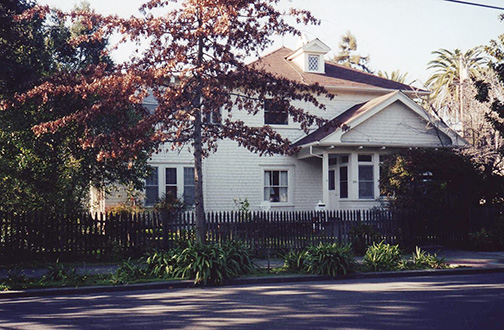 |
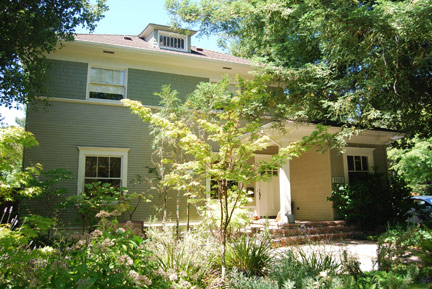 |
| November 2009 photo: 251 Lincoln showing early 20th century additions | 1102 Ramona, still original |
The additions to this wood–shingled house blend in scale and form with the original simple Colonial Revival design. The almost box–like footprint is relieved by an unusual pyramidal roof, with a pedimented dormer at its center. The enclosed eaves are defined by a tall, horizontal frieze board. This horizontal motif is repeated in a string course below the 2nd story window sills and in a foundation trim board with a string course cap.
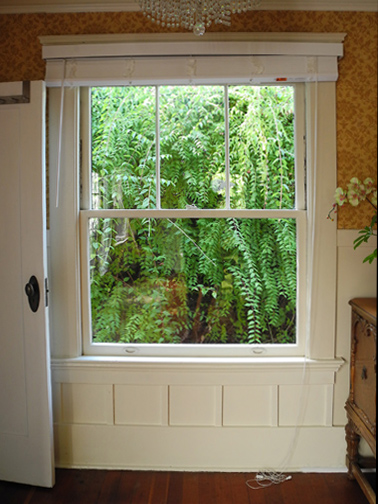 |
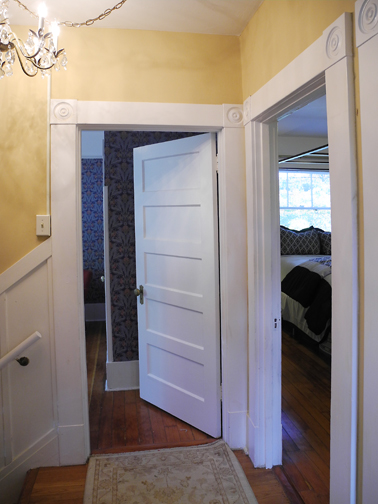 |
The double hung wood windows have vertical divided lites on the upper half over a single lower pane. Wide flat trim boards as well as drip cap molding accent some windows. Part of the early addition to the house contributed a two–story bay widow with a flat roof and decorative beams. Similarly, when an enclosed gable–roofed porch with a curved cornice and exposed rafters was added, the entry door was relocated to the side of the house.
The early 20th century remodel of the Isabel Charles house to suit the needs of her family is being repeated one hundred years later. Currently, 251 Lincoln is being restored and remodeled—along with the ubiquitous full basement—for a 21st century family. ©
PAST, August 14, 2015
E-mail us at either webmaster@pastheritage.org or president@pastheritage.org.
![]() Palo Alto Stanford Heritage—Dedicated to the preservation of Palo Alto's historic buildings.
Palo Alto Stanford Heritage—Dedicated to the preservation of Palo Alto's historic buildings.
Copyright © 2015 Palo Alto Stanford Heritage. All rights reserved.